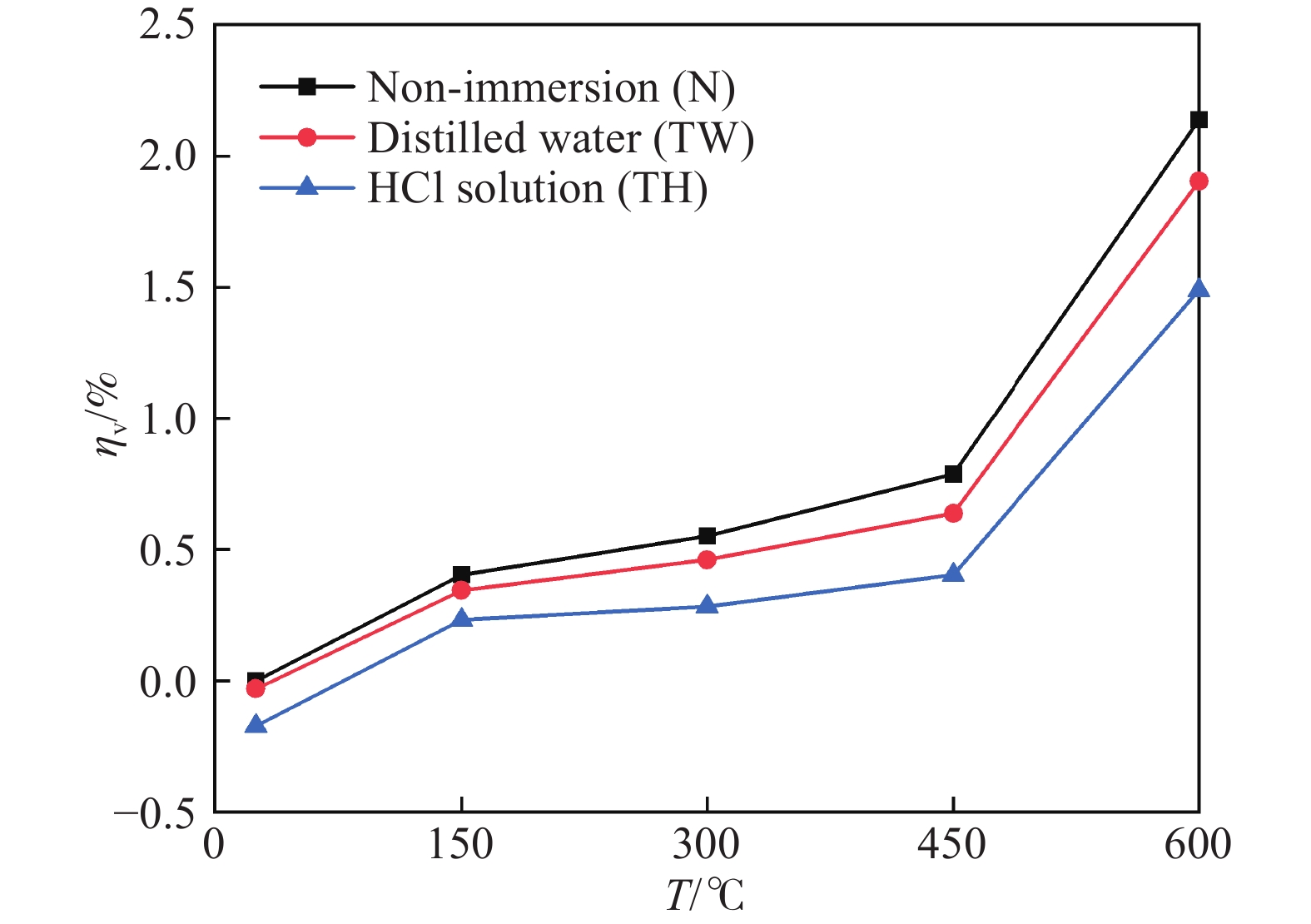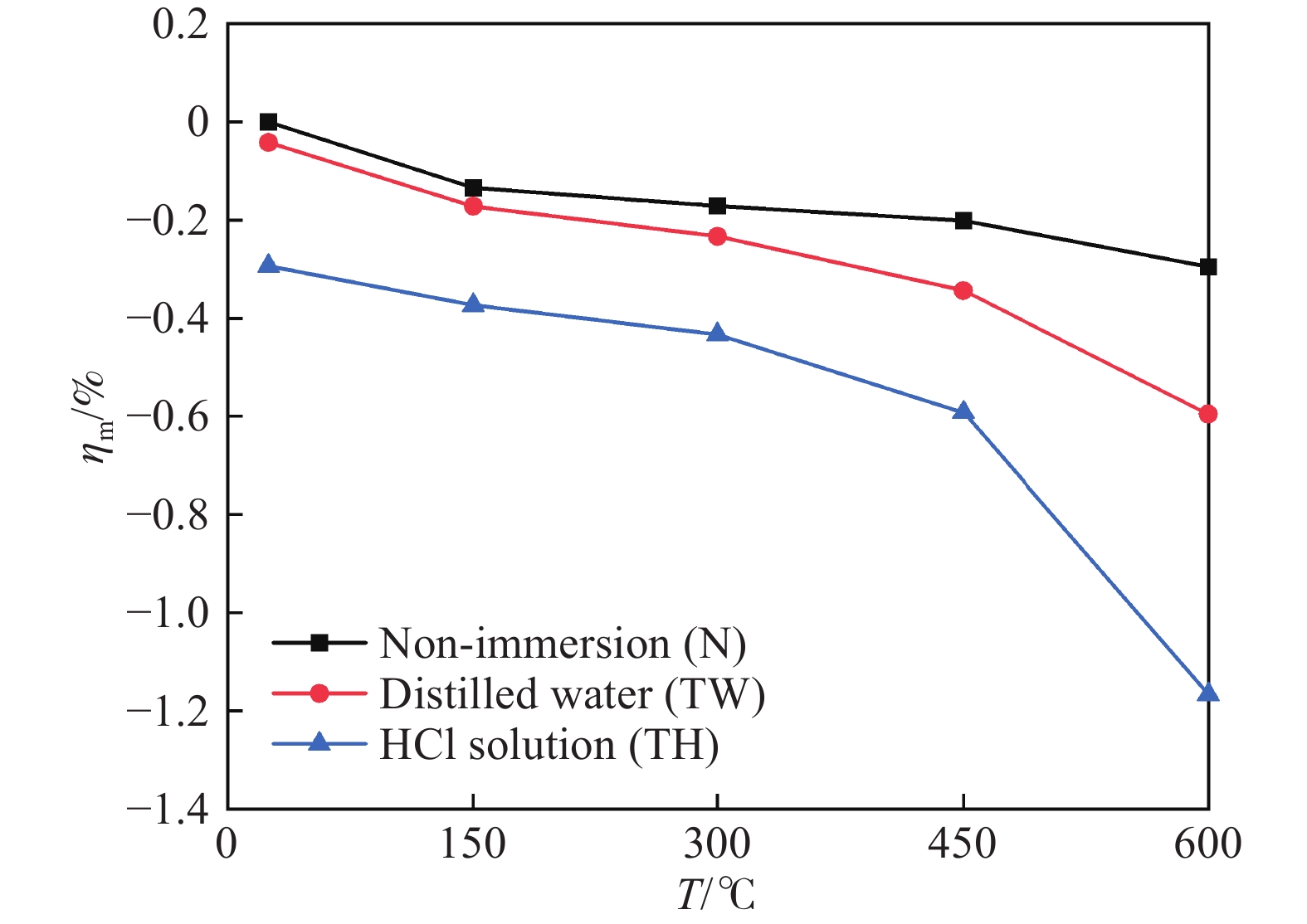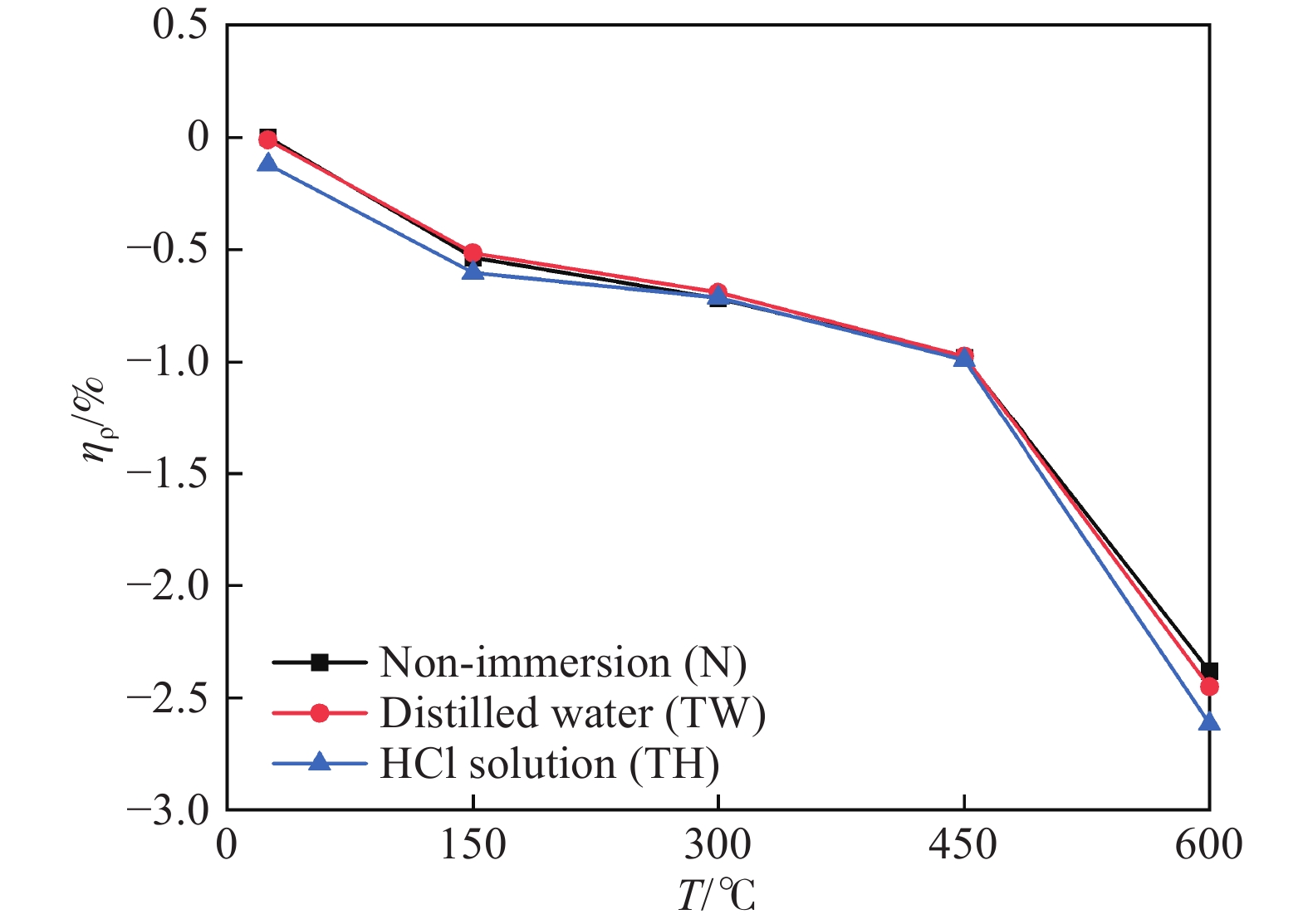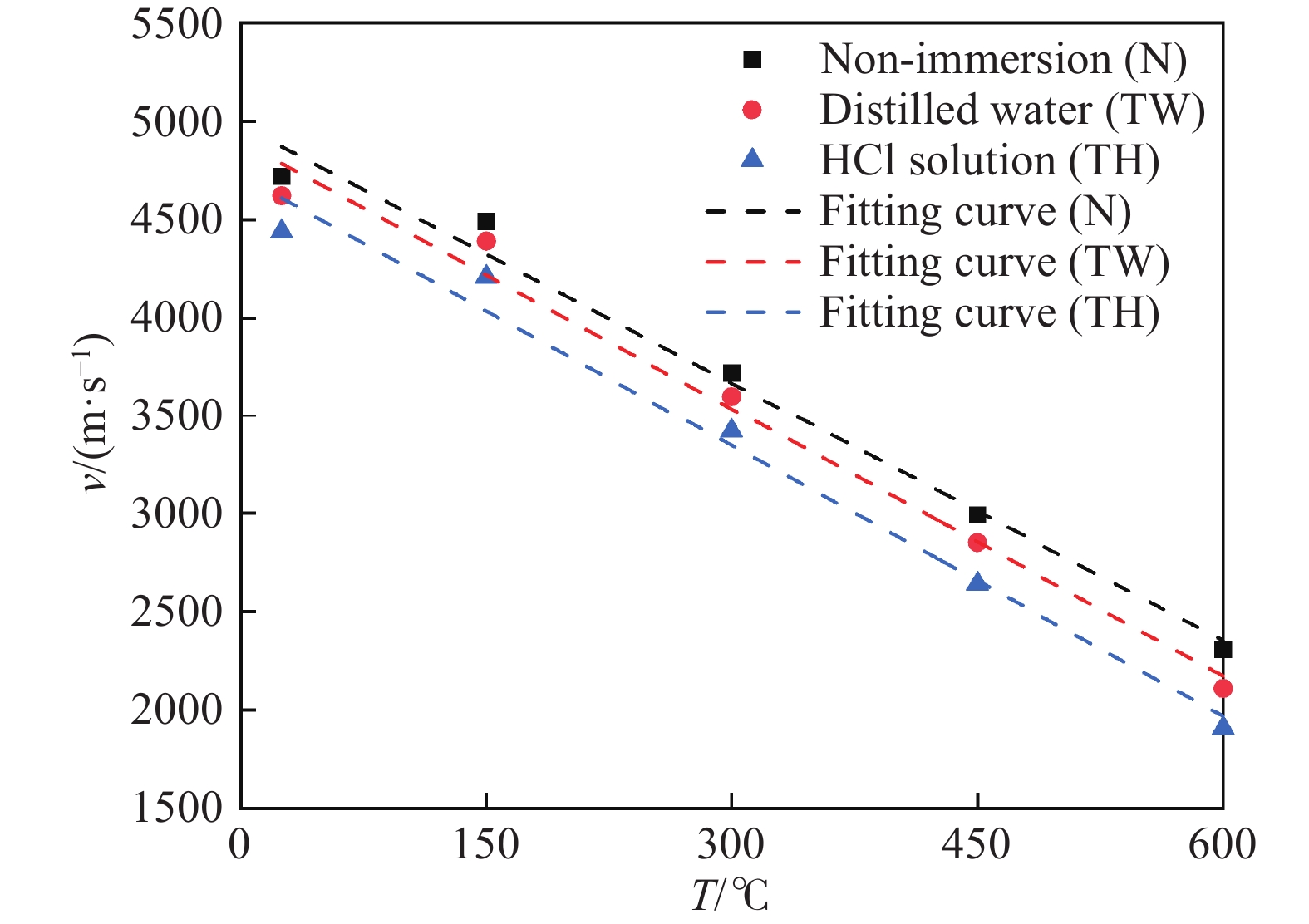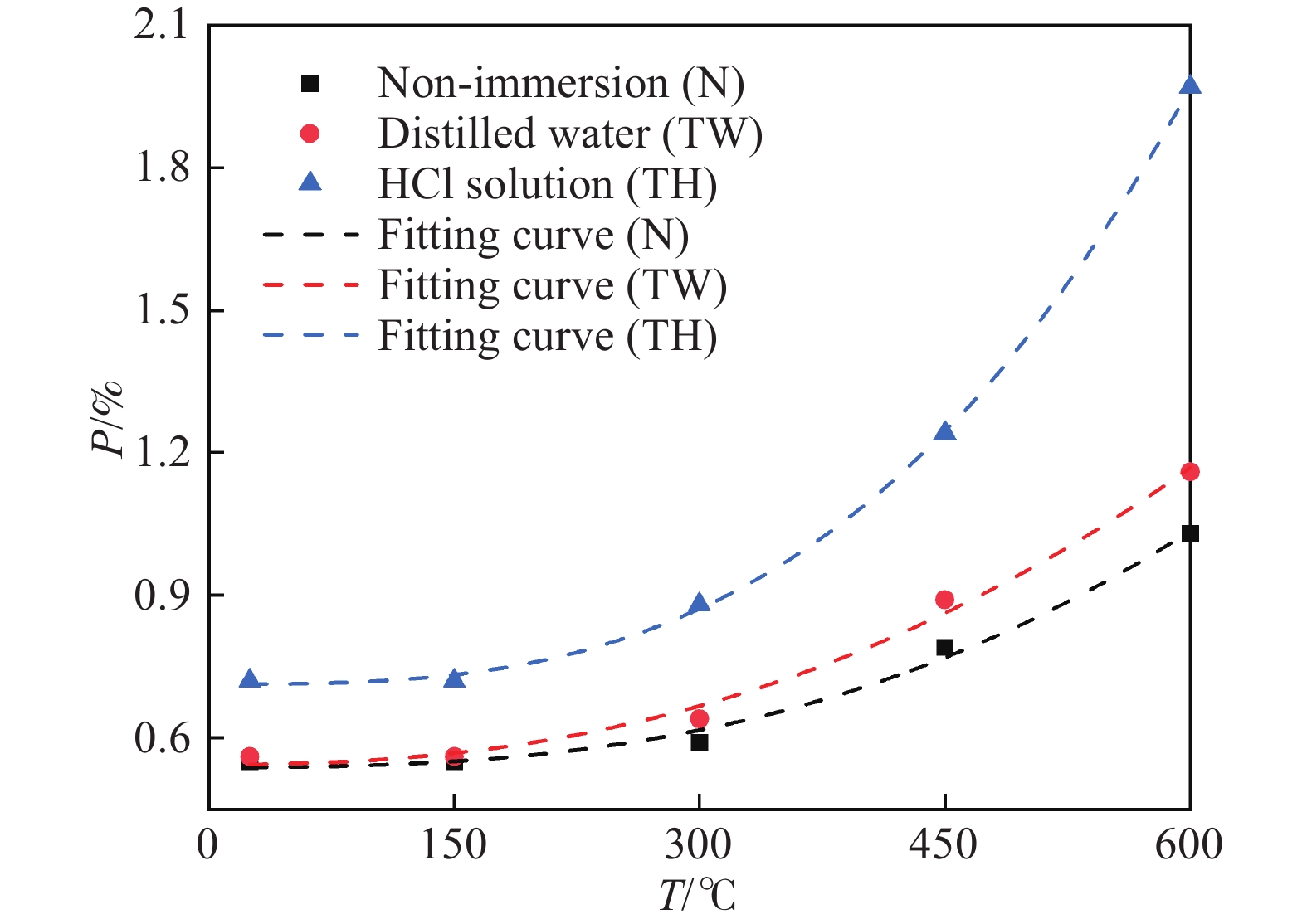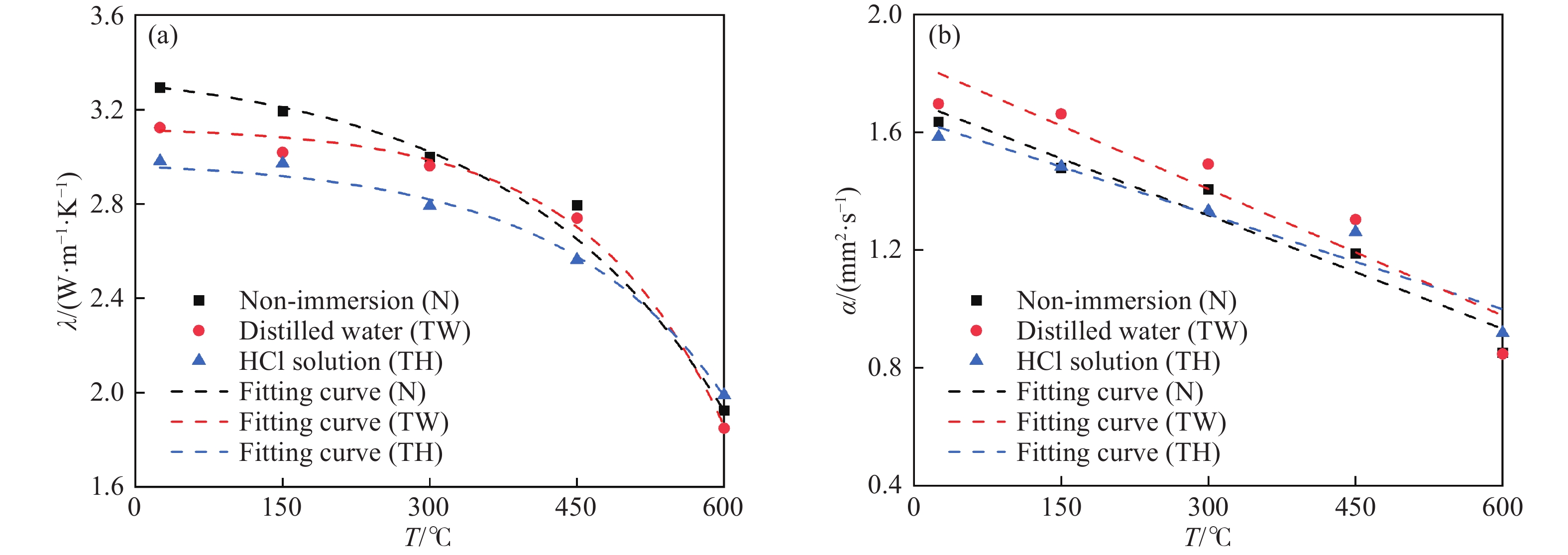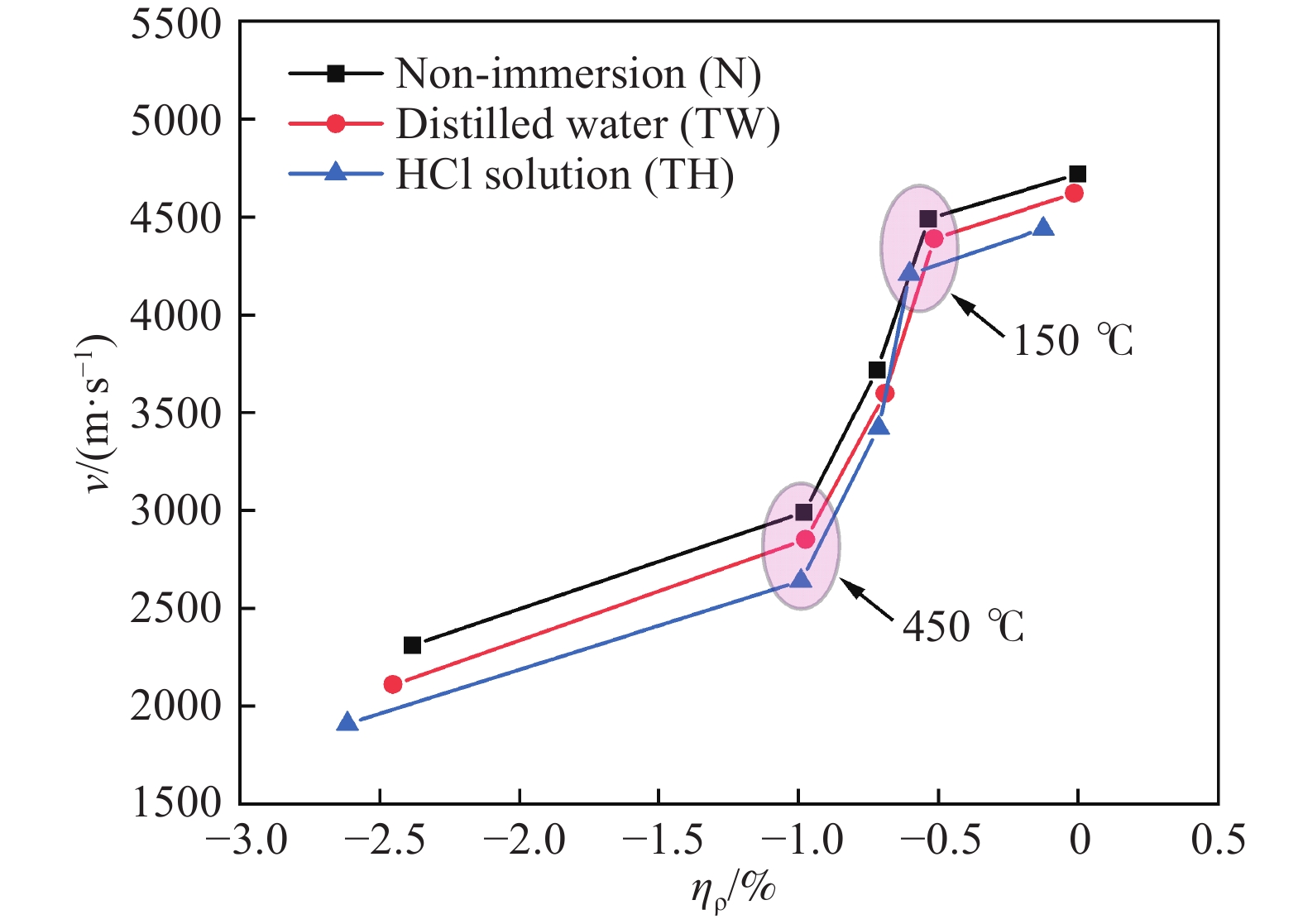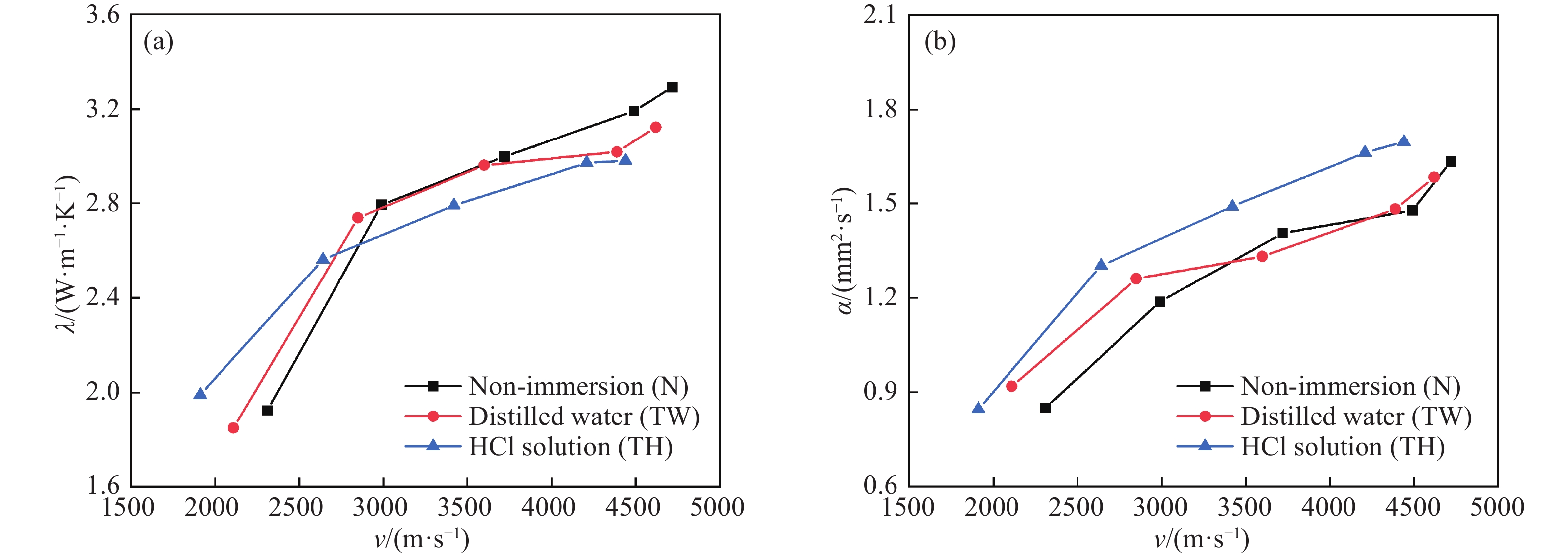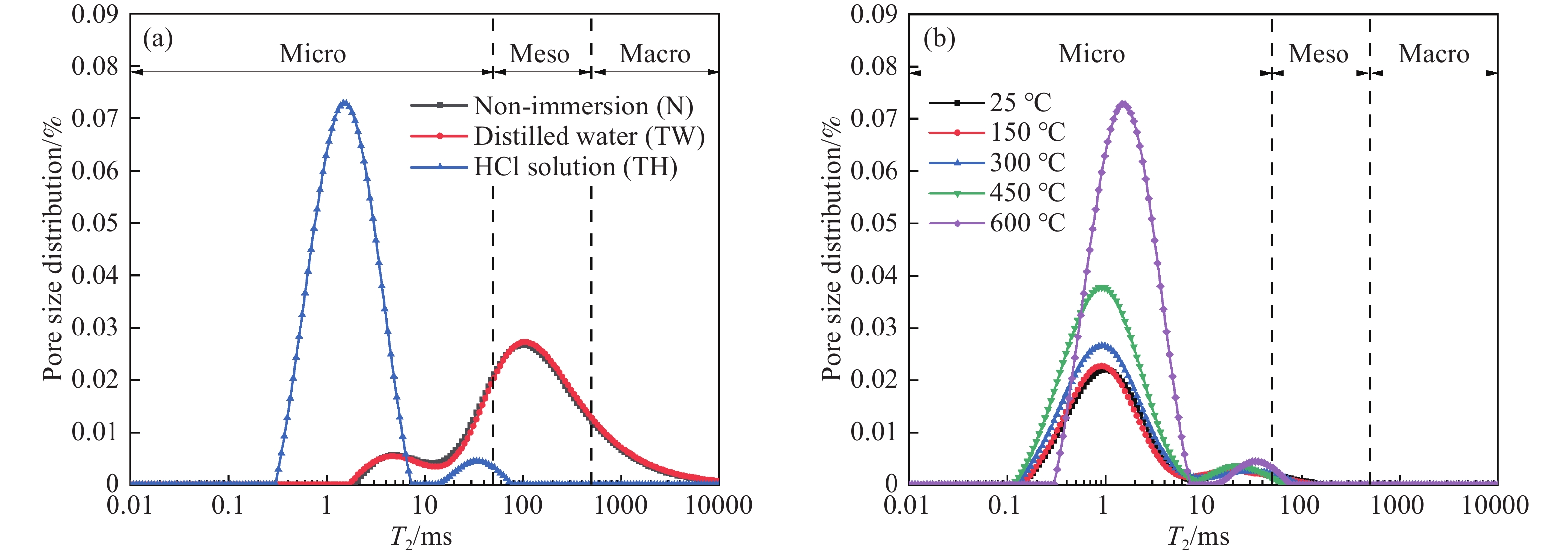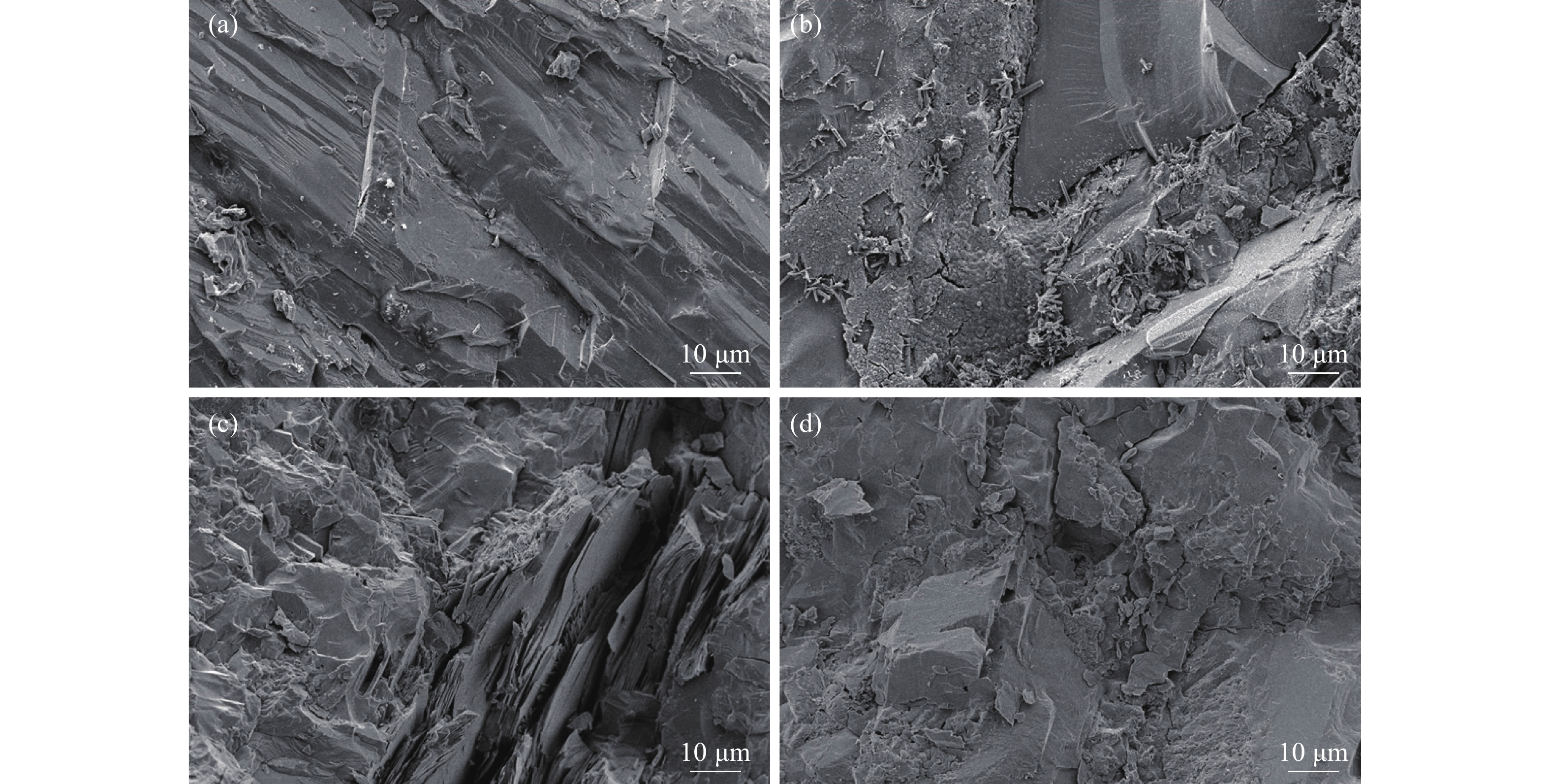Evolution mechanism of the physical properties and thermal conductivity of thermal shock granite under chemical immersion
-
摘要: 為了研究化學浸泡作用下熱沖擊花崗巖物理特性與導熱性能演化特征,對25~600 ℃范圍內不同溫度熱沖擊作用后的花崗巖試件開展了長期的酸性和中性溶液浸泡試驗,結合超聲檢測、核磁共振測試、熱常數分析和掃描電鏡試驗,定量表征了熱化改性花崗巖試件物理參數隨熱沖擊溫度的演化規律,建立了各物理參數之間的內在關聯性,揭示了物理性質變化的微觀機制。研究結果表明:隨著熱沖擊溫度的升高,熱化改性試件的體積逐漸增大,質量和密度逐漸降低,縱波波速呈線性下降,孔隙率呈冪函數遞增,導熱系數和熱擴散系數分別呈指數下降和線性下降;相同熱沖擊溫度下,熱化改性試件的體積增長率、縱波波速和導熱系數由大到小依次為未浸泡>水浸泡>酸浸泡,質量降低率和孔隙率從高到低依次為酸浸泡>水浸泡>未浸泡;孔隙率增大和導熱性能劣化均伴有縱波波速的下降,可通過測量縱波波速對孔隙率和導熱性能進行估測;熱化改性試件的孔隙結構對150~450 ℃范圍內的溫度更為敏感,固體顆粒骨架對450 ℃以上溫度更為敏感,顆粒骨架的劣化又將進一步引起孔隙結構的演化;熱化改性作用引起的微觀孔隙結構發育和物相轉變是導致物理性質變化的本質原因,其中以高溫熱沖擊起主導作用,研究發現300 ℃可作為產生強烈熱沖擊的溫度閾值。Abstract: To exploit the geothermal energy from low penetration rocks at a depth of 3–10 kilometers below the ground surface, an artificial geothermal system usually must be built. Thermal and chemical stimulation can be used as auxiliary means of hydraulic fracturing for artificial geothermal reservoir reconstruction, which is conducive to reducing the risk of earthquakes. However, thermal shock and chemical corrosion can also cause changes in physical parameters such as density, porosity, longitudinal wave velocity, and the thermal conductivity of high-temperature rock mass, which brings great uncertainty to the service life of a geothermal system. To study the evolution of the physical properties and thermal conductivity of thermal shock granite under chemical modification, long-term acid and neutral solution immersion tests were performed on granite specimens subjected to thermal shock at temperatures ranging from 25 ℃ to 600 ℃. Using ultrasonic testing, nuclear magnetic resonance, thermal constant testing, and scanning electron microscopy, the evolution of the physical parameters of thermal?chemical modified specimens with thermal shock temperature was quantitatively characterized, the internal correlation among physical parameters was established, and the microscopic mechanism of the change in physical properties was revealed. The results show that with increasing thermal shock temperature, the volume of thermal–chemical? modified specimens increases gradually, the mass and density decrease gradually, the longitudinal wave velocity decreases linearly, the porosity increases by a power function, and the thermal conductivity and thermal diffusivity decrease exponentially and linearly, respectively. At the same thermal shock temperature, the volume growth fraction, longitudinal wave velocity, and thermal conductivity of the modified specimens are in the order of non-immersion > water immersion > acid immersion, while the mass loss fraction and porosity are in the order of acid immersion > water immersion > non-immersion. The increase in porosity and the deterioration of thermal conductivity are accompanied by a decrease in longitudinal wave velocity, so the porosity and thermal conductivity can be estimated by measuring the longitudinal wave velocity. The pore structure of the modified specimens is more sensitive to temperatures in the range of 150–450 ℃, while the solid particle skeleton is more sensitive to temperatures above 450 ℃, and the deterioration of the particle skeleton will further cause the transformation of the pore structure. The thermal-chemical modification results in the development of pore structure and phase transformation, which are the fundamental reasons for the changes in the physical properties of granite. High-temperature thermal shock plays a leading role in the process of thermal-chemical modification, while chemical corrosion plays an auxiliary role. At the selected test temperature levels, 300 ℃ can be considered the temperature threshold for severe thermal shock.
-
久色视频
表 1 熱化改性花崗巖試件基本物理參數
Table 1. Basic physical parameters of thermal-chemical-modified granite
Specimen
numberHeat-treatment
temperature /
℃Soaking
conditionBefore modification After modification D0/mm H0/mm V0/cm3 m0/g ρ0/(g?cm?3) Da/mm Ha/mm Va/cm3 ma/g ρa/(g?cm?3) N-U0 25 Non-immersion 49.40 99.60 190.80 503.46 2.639 N-U1 150 49.40 100.15 191.86 503.35 2.624 49.47 100.27 192.63 502.68 2.610 N-U2 300 49.90 100.20 195.86 512.00 2.614 50.00 100.35 196.94 511.13 2.595 N-U3 450 49.55 100.05 192.83 504.44 2.616 49.69 100.27 194.35 503.43 2.590 N-U4 600 50.20 100.20 198.22 516.52 2.606 50.48 100.81 201.66 515.00 2.554 TW-U0 25 Distilled water 49.20 100.10 190.21 500.29 2.630 49.20 100.09 190.15 500.08 2.630 TW-U1 150 49.10 100.10 189.44 500.51 2.642 49.16 100.20 190.09 499.65 2.628 TW-U2 300 49.10 100.20 189.63 498.28 2.628 49.18 100.32 190.50 497.12 2.610 TW-U3 450 49.30 100.20 191.18 503.94 2.636 49.42 100.37 192.39 502.21 2.610 TW-U4 600 49.20 100.20 190.40 501.94 2.636 49.54 100.71 194.02 498.95 2.572 TH-U0 25 HCl solution 49.20 100.20 190.40 500.67 2.630 49.17 100.15 190.07 499.20 2.626 TH-U1 150 49.40 100.20 191.95 506.79 2.640 49.44 100.27 192.40 504.90 2.624 TH-U2 300 49.40 100.20 191.95 506.31 2.638 49.45 100.28 192.49 504.12 2.619 TH-U3 450 49.50 100.30 192.92 506.47 2.625 49.57 100.42 193.70 503.47 2.599 TH-U4 600 49.40 100.30 192.14 506.88 2.638 49.66 100.73 195.00 500.97 2.569 -
參考文獻
[1] Cai M F, Dor J. Chen X S, et al. Development strategy for co-mining of the deep mineral and geothermal resources. Strateg Study CAE, 2021, 23(6): 43蔡美峰, 多吉, 陳湘生, 等. 深部礦產和地熱資源共采戰略研究. 中國工程科學, 2021, 23(6):43 [2] Lin W J, Wang G L, Shao J L, et al. Distribution and exploration of hot dry rock resources in China: Progress and inspiration. Acta Geol Sin, 2021, 95(5): 1366 doi: 10.3969/j.issn.0001-5717.2021.05.004藺文靜, 王貴玲, 邵景力, 等. 我國干熱巖資源分布及勘探: 進展與啟示. 地質學報, 2021, 95(5):1366 doi: 10.3969/j.issn.0001-5717.2021.05.004 [3] Guo Q F, Xi X, Yang S, et al. Technology strategies to achieve carbon peak and carbon neutrality for China’s metal mines. Int J Miner Metall Mater, 2022, 29(4): 626 doi: 10.1007/s12613-021-2374-3 [4] Kelkar S, WoldeGabriel G, Rehfeldt K. Lessons learned from the pioneering hot dry rock project at Fenton Hill, USA. Geothermics, 2016, 63: 5 doi: 10.1016/j.geothermics.2015.08.008 [5] Zhang S Q, Wen D G, Xu T F, et al. The U. S. Frontier Observatory for Research in Geothermal Energy project and comparison of typical EGS site exploration status in China and U. S. Earth Sci Front, 2019, 26(2): 321 doi: 10.13745/j.esf.sf.2019.2.9張森琦, 文冬光, 許天福, 等. 美國干熱巖“地熱能前沿瞭望臺研究計劃”與中美典型EGS場地勘查現狀對比. 地學前緣, 2019, 26(2):321 doi: 10.13745/j.esf.sf.2019.2.9 [6] Wu X G, Huang Z W, Cheng Z, et al. Effects of cyclic heating and LN2-cooling on the physical and mechanical properties of granite. Appl Therm Eng, 2019, 156: 99 doi: 10.1016/j.applthermaleng.2019.04.046 [7] Sha S, Rong G, Chen Z H, et al. Experimental evaluation of physical and mechanical properties of geothermal reservoir rock after different cooling treatments. Rock Mech Rock Eng, 2020, 53(11): 4967 doi: 10.1007/s00603-020-02200-5 [8] Luo J, Zhu Y Q, Guo Q H, et al. Chemical stimulation on the hydraulic properties of artificially fractured granite for enhanced geothermal system. Energy, 2018, 142: 754 doi: 10.1016/j.energy.2017.10.086 [9] Norbeck J H, McClure M W, Horne R N. Field observations at the Fenton Hill enhanced geothermal system test site support mixed-mechanism stimulation. Geothermics, 2018, 74: 135 doi: 10.1016/j.geothermics.2018.03.003 [10] Liu H J, Shi Y K, Fang Z M, et al. Seepage characteristics of thermally and chemically treated Mesozoic granite from geothermal region of Liaodong Peninsula. Environ Earth Sci, 2021, 80(17): 1 [11] Zimmermann G, Bl?cher G, Reinicke A, et al. Rock specific hydraulic fracturing and matrix acidizing to enhance a geothermal system-Concepts and field results. Tectonophysics, 2011, 503(1-2): 146 doi: 10.1016/j.tecto.2010.09.026 [12] Portier S, Vuataz F D, Nami P, et al. Chemical stimulation techniques for geothermal wells: Experiments on the three-well EGS system at Soultz-sous-Forêts, France. Geothermics, 2009, 38(4): 349 doi: 10.1016/j.geothermics.2009.07.001 [13] Esteban L, Pimienta L, Sarout J, et al. Study cases of thermal conductivity prediction from P-wave velocity and porosity. Geothermics, 2015, 53: 255 doi: 10.1016/j.geothermics.2014.06.003 [14] Liu S, Xu J Y. An experimental study on the physico-mechanical properties of two post-high-temperature rocks. Eng Geol, 2015, 185: 63 doi: 10.1016/j.enggeo.2014.11.013 [15] Hu J J, Xie H P, Sun Q, et al. Changes in the thermodynamic properties of alkaline granite after cyclic quenching following high temperature action. Int J Min Sci Technol, 2021, 31(5): 843 doi: 10.1016/j.ijmst.2021.07.010 [16] Wu X H, Cai M F, Ren F H, et al. Evolutions of P-wave velocity and thermal conductivity of granite under different thermal treatments. Chin J Rock Mech Eng, 2022, 41(3): 457 doi: 10.13722/j.cnki.jrme.2021.0532吳星輝, 蔡美峰, 任奮華, 等. 不同熱處理作用下花崗巖縱波波速和導熱能力的演化規律分析. 巖石力學與工程學報, 2022, 41(3):457 doi: 10.13722/j.cnki.jrme.2021.0532 [17] Pan J L, Cai M F, Li P, et al. A damage constitutive model of rock-like materials containing a single crack under the action of chemical corrosion and uniaxial compression. J Central South Univ, 2022, 29(2): 486 doi: 10.1007/s11771-022-4949-1 [18] Zhang W Q, Sun Q, Hao S Q, et al. Experimental study on the variation of physical and mechanical properties of rock after high temperature treatment. Appl Therm Eng, 2016, 98: 1297 doi: 10.1016/j.applthermaleng.2016.01.010 [19] Wang F, Konietzky H. Thermo-mechanical properties of granite at elevated temperatures and numerical simulation of thermal cracking. Rock Mech Rock Eng, 2019, 52(10): 3737 doi: 10.1007/s00603-019-01837-1 [20] Farquharson J I, Kushnir A R L, Wild B, et al. Physical property evolution of granite during experimental chemical stimulation. Geotherm Energy, 2020, 8(1): 14 doi: 10.1186/s40517-020-00168-7 [21] Huang Z, Zeng W, Gu Q X, et al. Investigations of variations in physical and mechanical properties of granite, sandstone, and marble after temperature and acid solution treatments. Constr Build Mater, 2021, 307: 124943 doi: 10.1016/j.conbuildmat.2021.124943 [22] Li Z, Chen Y L, Wang S R, et al. Experimental research on mechanical properties of sandstone after chemical corrosion and high temperature exposure. J Univ Shanghai Sci Technol, 2019, 41(3): 244 doi: 10.13255/j.cnki.jusst.2019.03.006李哲, 陳有亮, 王蘇然, 等. 化學溶蝕及高溫作用下砂巖力學特性的試驗研究. 上海理工大學學報, 2019, 41(3):244 doi: 10.13255/j.cnki.jusst.2019.03.006 [23] Li Z, Chen Y L, Wang S R, et al. Experimental research on mechanical properties of sandstone in chemical corrosion under high or low temperature action. Ind Constr, 2018, 48(8): 103 doi: 10.13204/j.gyjz201808018李哲, 陳有亮, 王蘇然, 等. 經化學溶蝕并高低溫作用后砂巖的力學特性試驗研究. 工業建筑, 2018, 48(8):103 doi: 10.13204/j.gyjz201808018 [24] Liu M L, Zhuang Y Q, Zhou C, et al. Application of chemical stimulation technology in enhanced geothermal system: Theory, practice and expectation. J Earth Sci Environ, 2016, 38(2): 267 doi: 10.3969/j.issn.1672-6561.2016.02.014劉明亮, 莊亞芹, 周超, 等. 化學刺激技術在增強型地熱系統中的應用: 理論、實踐與展望. 地球科學與環境學報, 2016, 38(2):267 doi: 10.3969/j.issn.1672-6561.2016.02.014 [25] Zhang W Q. Study on the Microscopic Mechanism of Rock Thermal Damage and the Evolution Characteristics of Macroscopic Physical and Mechanical Properties—Taking Typical Rock as an Example[Dissertation]. Xuzhou: China University of Mining and Technology, 2017張衛強. 巖石熱損傷微觀機制與宏觀物理力學性質演變特征研究— —以典型巖石為例[學位論文]. 徐州: 中國礦業大學, 2017 [26] Chen S W, Yang C H, Wang G B. Evolution of thermal damage and permeability of Beishan granite. Appl Therm Eng, 2017, 110: 1533 doi: 10.1016/j.applthermaleng.2016.09.075 [27] Zhao X G, Wang J, Chen F, et al. Experimental investigations on the thermal conductivity characteristics of Beishan granitic rocks for China’s HLW disposal. Tectonophysics, 2016, 683: 124 doi: 10.1016/j.tecto.2016.06.021 [28] Li Y, Zhang C, Song W D, et al. Elastic longitudinal wave and porosity of subsea gold deposits. J China Univ Min Technol, 2021, 50(2): 239 doi: 10.13247/j.cnki.jcumt.001224李楊, 張超, 宋衛東, 等. 海底金礦巖石彈性縱波與孔隙率特性. 中國礦業大學學報, 2021, 50(2):239 doi: 10.13247/j.cnki.jcumt.001224 [29] Li S, Ni G H, Wang H, et al. Effects of acid solution of different components on the pore structure and mechanical properties of coal. Adv Powder Technol, 2020, 31(4): 1736 doi: 10.1016/j.apt.2020.02.009 [30] Chu F J, Liu D W, Tao M, et al. Dynamic damage laws of sandstone under different water bearing conditions based on nuclear magnetic resonance. Chin J Eng, 2018, 40(2): 144褚夫蛟, 劉敦文, 陶明, 等. 基于核磁共振的不同含水狀態砂巖動態損傷規律. 工程科學學報, 2018, 40(2):144 -




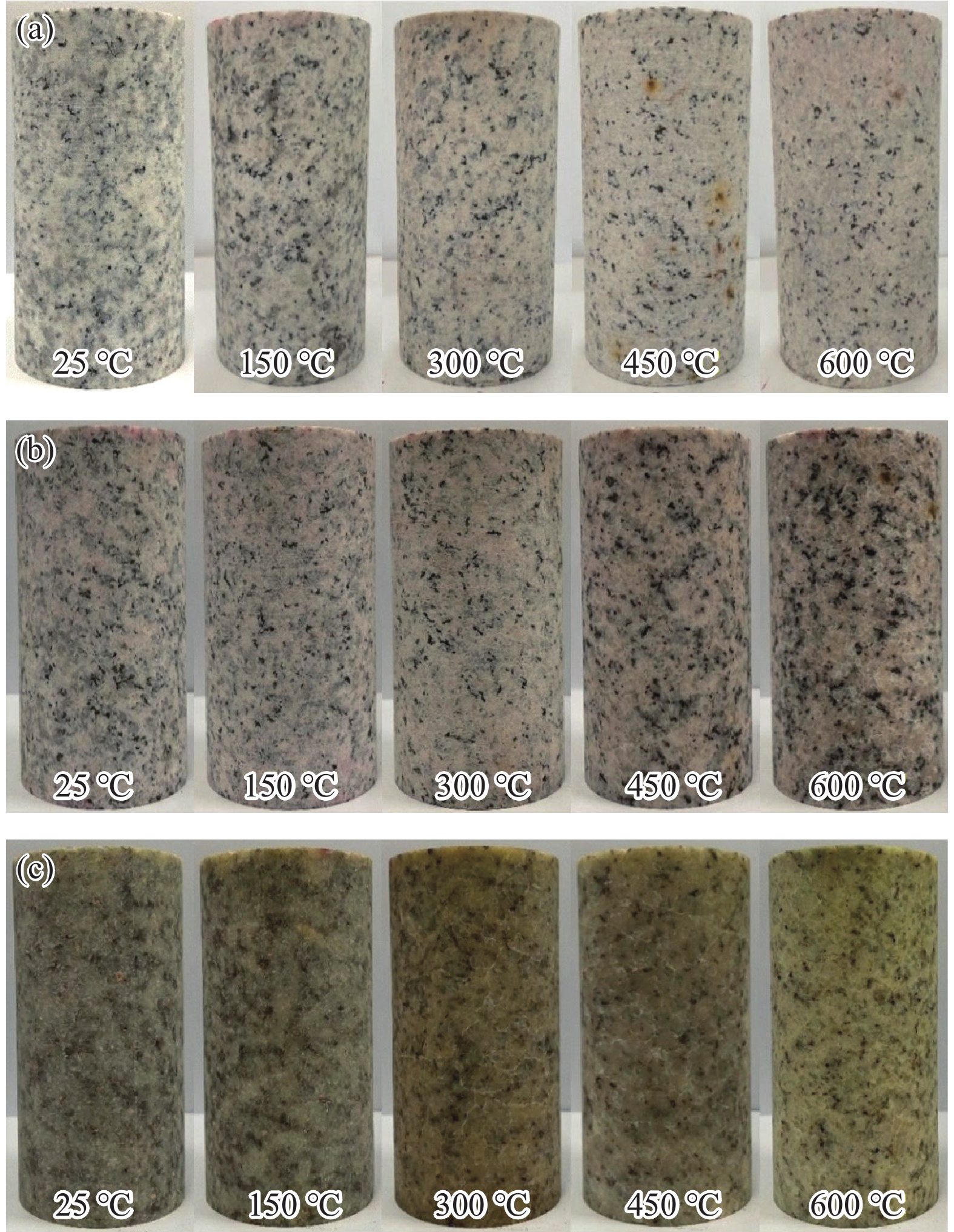
 下載:
下載:
